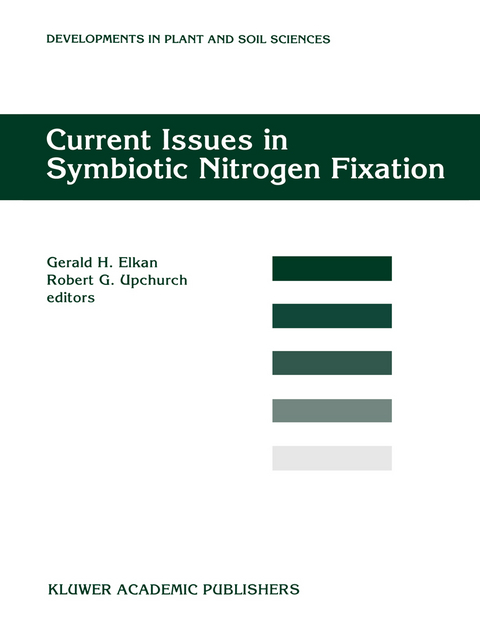
Current Issues in Symbiotic Nitrogen Fixation
Springer (Verlag)
978-94-010-6404-0 (ISBN)
In the 100 years since the legume-Rhizobium symbiotic nitrogen fixation interaction was first described, interest in this field has grown rapidly. The types of studies have been cyclical in nature, involving a cross-section of disciplines. The availability of cheap nitrogenous fertilizers caused much of the biological nitrogen fixation research to become more theoretical in the developed world. The high cost of energy, coupled with environmental concerns and the interest in sustainable agriculture, has stimulated research in symbiotic nitrogen fixation. The development of modern genetic techniques has resulted in interdisciplinary research on plant-microbe interactions controlling nitrogen fixation. This has resulted in a better understanding of environmental factors influencing the nodulation process, chemical signalling between the symbiotic partners and the nature of the specificity between host plant and microsymbiotant.
This volume summarizes the diverse research efforts in biological nitrogen fixation by presenting a collection of papers in the areas of physiology and metabolism, taxonomy and evolution, genetics and ecology.
1. Advances in the positional cloning of nodulation genes in soybean.- 2. Molecular analysis of actinorhizal symbiotic systems: Progress to date.- 3. Diversity of Rhizobia isolated from various Hedysarum species.- 4. Diazotrophic endophytes: progress and prospects for nitrogen fixation in monocots.- 5. Drought-avoidant soybean germplasm maintains nitrogen-fixation capacity under water stress.- 6. Phylogeny and taxonomy of rhizobia.- 7. Comparison of rhizobitoxine-induced inhibition of ?-cystathionase from different bradyrhizobia and soybean genotypes.- 8. Assimilation of nod gene inducer 14C-naringenin and the incorporation of labelled carbon atoms into the acyl side chain of a host-specific Nod factor produced by Rhizobium leguminosarum bv. viciae.- 9. Corresponding 16S rRNA gene segments in Rhizobiaceae and Aeromonas yield discordant phylogenies.- 10. Rapid evaluation of peat-base legume inoculant using immunomagnetic beads for cell retrieval and fluorescent nucleic acid probes for viability analysis.- 11. Detection of genetic variation in Bradyrhizobium japonicum USDA 110 variants using DNA fingerprints generated with GC rich arbitrary PCR primers.- 12. Mimosine produced by the tree-legume Leucaena provides growth advantages to some Rhizobium strains that utilize it as a source of carbon and nitrogen.- 13. Subnanomolar concentrations of membrane chitolipooligosaccharides from Rhizobium leguminosarum biovar trifolii are fully capable of eliciting symbiosis-related responses on white clover.- 14. Analysis of the two nodulins, sucrose synthase and ENOD2, in transgenic Lotus plants.- 15. Hopanoid lipids in Bradyrhizobium and other plant-associated bacteria and cloning of the Bradyrhizobium japonicum squalene-hopene cyclase gene.- 16. Presence of unique repeatedinsertion sequences in nodulation genes of Rhizobium 'hedysari'.- 17. Enhanced competitiveness of a Bradyrhizobium japonicum mutant strain improved for nodulation and nitrogen fixation.- 18. Phage susceptibility and plasmid profile analysis of Sinorhizobiumfredii.- 19. A diazotrophic bacterial endophyte isolated from stems of Zea mays L. and Zea luxurians Iltis and Doebley.- 20. Identification of enzymes involved in indole-3-acetic acid degradation.- 21. Toward a new concept of the evolution of symbiotic nitrogen fixation in the Leguminosae.- 22. Lipopolysaccharide core components of Rhizobium etli reacting with a panel of monoclonal antibodies.- 23. Diversity in symbiotic specificity of cowpea rhizobia indigenous to Zimbabwean soils.- 24. Host genetic control of symbiosis in soybean (Glycine max L.).- 25. A comparison of the binding of Agrobacterium tumefaciens and Rhizobium meliloti to alfalfa roots, carrot suspension culture cells, and Arabidopsis thaliana root segments.- 26. Symbiotic effectiveness of marked rhizobial and bradyrhizobial mutants in pea, pigeonpea and mungbean.
| Reihe/Serie | Developments in Plant and Soil Sciences ; 72 |
|---|---|
| Zusatzinfo | IX, 198 p. |
| Verlagsort | Dordrecht |
| Sprache | englisch |
| Maße | 195 x 260 mm |
| Themenwelt | Studium ► 2. Studienabschnitt (Klinik) ► Humangenetik |
| Naturwissenschaften ► Biologie ► Biochemie | |
| Naturwissenschaften ► Biologie ► Botanik | |
| Naturwissenschaften ► Biologie ► Mikrobiologie / Immunologie | |
| Naturwissenschaften ► Geowissenschaften ► Geologie | |
| ISBN-10 | 94-010-6404-0 / 9401064040 |
| ISBN-13 | 978-94-010-6404-0 / 9789401064040 |
| Zustand | Neuware |
| Haben Sie eine Frage zum Produkt? |
aus dem Bereich


